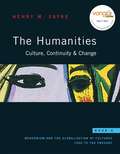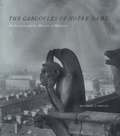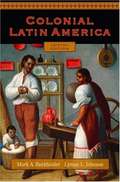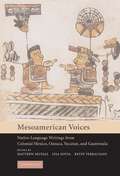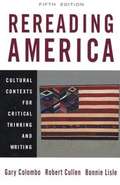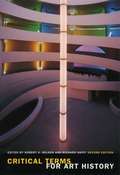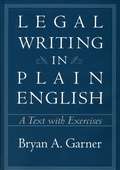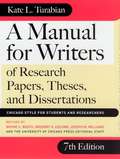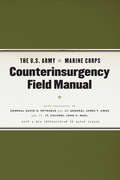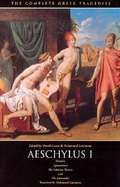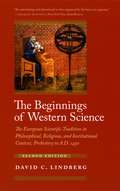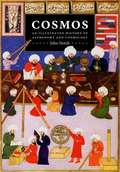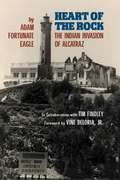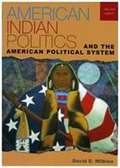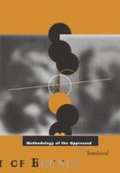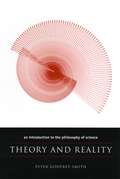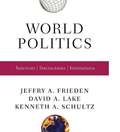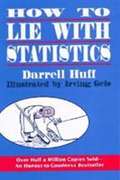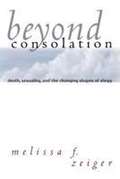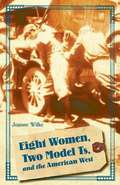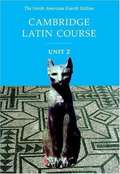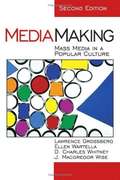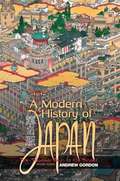- Table View
- List View
The Humanities: Modernism and the Globalization of Cultures, 1900 to the Present
by Henry M. SayreThe Humanities by Henry M. Sayre helps the reader see the context and make the connections across the humanities by tying together the entire cultural experience through a narrative storytelling approach.
The Gargoyles of Notre Dame: Medievalism and the Monsters of Modernity
by Michael CamilleMost of the seven million people who visit the cathedral of Notre Dame in Paris each year probably do not realize that the legendary gargoyles adorning this medieval masterpiece were not constructed until the nineteenth century.
Colonial Latin America (6th edition)
by Mark A. Burkholder Lyman L. JohnsonNow in its sixth edition, "Colonial Latin America" provides a concise study of the history of the Iberian colonies in the New World from their pre-conquest background to the wars of independence in the early nineteenth century. The new edition of this highly acclaimed text has been revised and updated to reflect the latest scholarship, with particular emphasis on social and cultural history. It also features a new section on pre-Colonial Africa, to parallel coverage of pre-Colonial Spain and the Americas.
Mesoamerican Voices: Native-Language Writings from Colonial Mexico, Oaxaca, Yucatan, and Guatemala
by Matthew Restall Lisa Sousa Kevin TerracianoTranslated into English, these texts were written from the sixteenth through the eighteenth centuries by Nahuas from central Mexico, Mixtecs from Oaxaca, Maya from Yucatan, and other groups from Mexico and Guatemala. This collection provides college teachers and students access to important new sources for the history of Latin America and Native Americans. It is the first to present the translated writings of so many native groups and to address such a variety of topics, including conquest, government, land, household, society, gender, religion, writing, law, crime, and morality.
Rereading America: Cultural Contexts for Critical Thinking and Writing (5th edition)
by Gary Colombo Robert Cullen Bonnie LisleRereading America presents diverse political and cultural perspectives as grist for critical thinking. Many of the book's 73 selections are from groups that have been pushed to the margins of our society -- people of color, women, gays and lesbians.
Property Management (4th edition)
by Walter Roy Huber Arlette Lyons William H. PivarUnderstanding the use and meanings of the terminology found in this textbook is paramount to a successful career in the real estate property management field.
Critical Terms for Art History (2nd edition)
by Robert S. Nelson Richard Shiff"Art" has always been contested terrain, whether the object in question is a medieval tapestry or Duchamp's Fountain.
Boundaries: Readings in Deviance, Crime and Criminal Justice
by Ralph B. Mcneal Jr. Bradley R. E. WrightReadings in Deviance, Crime and Criminal Justice
Legal Writing in Plain English: A Text with Exercises
by Bryan A. GarnerAdmirably clear, concise, down-to-earth, and powerful-- unfortunately, these adjectives rarely describe legal writing, whether in the form of briefs, opinions, contracts, or statutes. In Legal Writing in Plain English, Bryan A. Garner provides lawyers, judges, paralegals, law students, and legal scholars sound advice and practical tools for improving their written work. The book encourages legal writers to challenge conventions and offers valuable insights into the writing process: how to organize ideas, create and refine prose, and improve editing skills. In essence, it teaches straight thinking-- a skill inseparable from good writing. Replete with common sense and wit, the book draws on real-life writing samples that Garner has gathered through more than a decade of teaching in the field. Trenchant advice covers all types of legal materials, from analytical and persuasive writing to legal drafting. Meanwhile, Garner explores important aspects of document design. Basic, intermediate, and advanced exercises in each section reinforce the book's principles. (An answer key to basic exercises is included in the book; answers to intermediate and advanced exercises are provided in a separate Instructor's Manual, free of charge to instructors.) Appendixes include a comprehensive punctuation guide with advice and examples, and four model documents. Today more than ever before, legal professionals cannot afford to ignore the trend toward clear language shorn of jargon. Clients demand it, and courts reward it. Despite the age-old tradition of poor writing in law, Legal Writing in Plain English shows how legal writers can unshackle themselves. Legal Writing in Plain English includes: *Tips on generating thoughts, organizing them, and creating outlines. *Sound advice on expressing your ideas clearly and powerfully. *Dozens of real-life writing examples to illustrate writing problems and solutions. *Exercises to reinforce principles of good writing (also available on the Internet). *Helpful guidance on page layout. *A punctuation guide that shows the correct uses of every punctuation mark. *Model legal documents that demonstrate the power of plain English.
A Manual for Writers of Research Papers, Theses, and Dissertations: Chicago Style for Students and Researchers (7th edition)
by Kate L. Turabian Wayne C. Booth Gregory G. Colomb Joseph M. WilliamsThis seventh edition of Turabian's "Manual" is a classic reference revised for a new age. It is tailored to a new generation of writers using tools its original author could not have imagined-- while retaining the clarity and authority that generations of scholars have come to associate with the name Turabian.
The U. S. Army / Marine Corps Counterinsurgency Field Manual
by John A. Nagl David H. Petraeus James F. Amos Sarah SewallWhen the U.S. military invaded Iraq, it lacked a common understanding of the problems inherent in counterinsurgency campaigns. It had neither studied them, nor developed doctrine and tactics to deal with them. It is fair to say that in 2003, most Army officers knew more about the U.S. Civil War than they did about counterinsurgency. The U.S. Army / Marine Corps Counterinsurgency Field Manual was written to fill that void. The result of unprecedented collaboration among top U.S. military experts, scholars, and practitioners in the field, the manual espouses an approach to combat that emphasizes constant adaptation and learning, the importance of decentralized decision-making, the need to understand local politics and customs, and the key role of intelligence in winning the support of the population. The manual also emphasizes the paradoxical and often counter-intuitive nature of counterinsurgency operations: sometimes the more you protect your forces, the less secure you are; sometimes the more force you use, the less effective it is; sometimes doing nothing is the best reaction. An new introduction by Sarah Sewall, director of the Carr Center for Human Rights Policy at Harvard's Kennedy School of Government, places the manual in critical and historical perspective, explaining the significance and potential impact of this revolutionary challenge to conventional U.S. military doctrine. An attempt by our military to redefine itself in the aftermath of 9/11 and the new world of international terrorism,The U.S. Army / Marine Corps Counterinsurgency Field Manual will play a vital role in American military campaigns for years to come.
Aeschylus I: Agamemnon, The Libation Bearers, The Eumenides (The Complete Greek Tragedies #1)
by Aeschylus David Grene Richmond Lattimore"These authoritative translations consign all other complete collections to the wastebasket."--Robert Brustein, The New Republic. "This is it. No qualifications. Go out and buy it everybody."--Kenneth Rexroth, The Nation. "The translations deliberately avoid the highly wrought and affectedly poetic; their idiom is contemporary.... They have life and speed and suppleness of phrase."--Times Education Supplement. "These translations belong to our time. A keen poetic sensibility repeatedly quickens them; and without this inner fire the most academically flawless rendering is dead."--Warren D. Anderson, American Oxonian. "The critical commentaries and the versions themselves... are fresh, unpretentious, above all, functional."--Commonwealth. "Grene is one of the great translators."--Conor Cruise O'Brien, London Sunday Times. "Richmond Lattimore is that rara avis in our age, the classical scholar who is at the same time an accomplished poet."--Dudley Fitts, New York Times Book Review.
The Beginnings of Western Science: The European Scientific Tradition in Philosophical, Religious, and Institutional Context, Prehistory to A.D. 1450 (2nd edition)
by David C. LindbergWhen it was first published in 1992, The Beginnings of Western Science was lauded as the first successful attempt ever to present a unified account of both ancient and medieval science in a single volume. Chronicling the development of scientific ideas, practices, and institutions from pre-Socratic Greek philosophy to late-Medieval scholasticism, David C. Lindberg surveyed all the most important themes in the history of science, including developments in cosmology, astronomy, mechanics, optics, alchemy, natural history, and medicine. In addition, he offered an illuminating account of the transmission of Greek science to medieval Islam and subsequently to medieval Europe. Beginnings of Western Science was, and remains, a landmark in the history of science, shaping the way students and scholars understand these critically formative periods of scientific development. It reemerges here in a second edition that includes revisions on nearly every page, as well as several sections that have been completely rewritten. For example, the section on Islamic science has been thoroughly retooled to reveal the magnitude and sophistication of medieval Muslim scientific achievement. And the book now reflects a sharper awareness of the importance of Mesopotamian science for the development of Greek astronomy. In all, the second edition of The Beginnings of Western Science captures the current state of our understanding of more than two millennia of science and promises to continue to inspire both students and general readers.
Cosmos: An Illustrated History of Astronomy and Cosmology
by John D. NorthFor millennia humans have studied the skies to help them grow crops, navigate the seas, and earn favor from their gods. We still look to the stars today for answers to fundamental questions: How did the universe begin? Will it end, and if so, how? What is our place within it? John North has been examining such questions for decades. In Cosmos, he offers a sweeping historical survey of the two sciences that help define our place in the universe: astronomy and cosmology. Organizing his history chronologically, North begins by examining Paleolithic cave drawings that clearly chart the phases of the moon. He then investigates scientific practices in the early civilizations of Egypt, Greece, China, and the Americas (among others), whose inhabitants developed sophisticated methods to record the movements of the planets and stars. Trade routes and religious movements, North notes, brought these ancient styles of scientific thinking to the attention of later astronomers, whose own theories-- such as Copernicus' planetary theory-- led to the Scientific Revolution. The work of master astronomers, including Ptolemy, Galileo, Kepler, and Newton, is described in detail, as are modern-day developments in astrophysics, such as the advent of radio astronomy, the brilliant innovations of Einstein, and the many recent discoveries brought about with the help of the Hubble telescope. This new edition brings North's seminal book right up to the present day, as North takes a closer look at last year's reclassification of Pluto as a "dwarf" planet and gives a thorough overview of current research. With more than two hundred illustrations and a comprehensive bibliography, Cosmos is the definitive history of astronomy and cosmology. It is sure to find an eager audience among historians of science and astronomers alike.
Heart of the Rock: The Indian Invasion of Alcatraz
by Adam Fortunate Eagle Tim FindleyAn intimate memoir of the two-year invasion and occupation of Alcatraz by American Indians and of the events leading up to it. Traces and cultural agonies and federal pressures on American Indians "relocated" to urban areas that led to the invasion of Alcatraz.
American Indian Politics and the American Political System (2nd edition)
by David E. WilkinsIn this college textbook, Wilkins (American Indian studies, political science, law, and American studies, U. of Minnesota) considers the relationship of American Indian governments to the American political system with emphasis on the sovereignty of tribal nations. He analyzes the status of indigenous peoples and their citizenship, the concept of tribal sovereignty and the issues policymakers have, and their relationship with the government's branches. He provides an overview of federal Indian policy in history, descriptions of tribal governments, political economy and gaming, participation, interest-group activities and social activism, and the effect of the media. This edition integrates new census data; discussions of changes to elections, US House and Senate personnel, and legislation on Indian rights and the state-tribal relationship; and information on George W. Bush's terms in office. Annotation ©2006 Book News, Inc., Portland, OR (booknews.com)
Methodology of the Oppressed
by Chela SandovalIn a work with far-reaching implications, Chela Sandoval does no less than revise the genealogy of theory over the past thirty years, inserting what she terms "U.S. Third World feminism" into the narrative in a way that thoroughly alters our perspective on contemporary culture and subjectivity. What Sandoval has identified is a language, a rhetoric of resistance to postmodern cultural conditions. U.S liberation movements of the post-World War II era generated specific modes of oppositional consciousness. Out of these emerged a new activity of consciousness and language Sandoval calls the "methodology of the oppressed". This methodology -- born of the strains of the cultural and identity struggles that currently mark global exchange -- holds out the possibility of a new historical moment, a new citizen-subject, and a new form of alliance consciousness and politics. Utilizing semiotics and U.S. Third World feminist criticism, Sandoval demonstrates how this methodology mobilizes love as a category of critical analysis. Rendering this approach in all its specifics, Methodology of the Oppressed gives rise to an alternative mode of criticism opening new perspectives on a theoretical, literary, aesthetic, social movement, or psychic expression.
Theory and Reality: An Introduction to the Philosophy of Science
by Peter Godfrey-SmithHow does science work? Does it tell us what the world is "really" like? What makes it different from other ways of understanding the universe? In Theory and Reality, Peter Godfrey-Smith addresses these questions by taking the reader on a grand tour of one hundred years of debate about science. The result is a completely accessible introduction to the main themes of the philosophy of science. Intended for undergraduates and general readers with no prior background in philosophy, Theory and Reality covers logical positivism; the problems of induction and confirmation; Karl Popper's theory of science; Thomas Kuhn and "scientific revolutions"; the views of Imre Lakatos, Larry Laudan, and Paul Feyerabend; and challenges to the field from sociology of science, feminism, and science studies. The book then looks in more detail at some specific problems and theories, including scientific realism, the theory-ladeness of observation, scientific explanation, and Bayesianism. Finally, Godfrey-Smith defends a form of philosophical naturalism as the best way to solve the main problems in the field. Throughout the text he points out connections between philosophical debates and wider discussions about science in recent decades, such as the infamous "science wars." Examples and asides engage the beginning student; a glossary of terms explains key concepts; and suggestions for further reading are included at the end of each chapter. However, this is a textbook that doesn't feel like a textbook because it captures the historical drama of changes in how science has been conceived over the last one hundred years. Like no other text in this field, Theory and Reality combines a survey of recent history of the philosophy of science with current key debates in language that any beginning scholar or critical reader can follow.
World Politics
by Jeffry A. Frieden David A. Lake Kenneth A. SchultzWhy are there wars? Why do countries have a hard time cooperating to prevent genocides or global environmental problems? Why are some countries rich while others are poor? Organized around the puzzles that draw scholars and students alike to the study of world politics, this book gives students the tools they need to think analytically about compelling questions like these. World Politics introduces a contemporary analytical framework based on interests, interactions, and institutions. Drawing extensively on recent research, the authors use this flexible framework throughout the text to get students thinking like political scientists as they explore the major topics in international relations.
How to Lie with Statistics
by Darrell Huff Irving GeisA 1954 classic that continues to dispel false beliefs and inform the statistically naive. Huff's direct and witty style exposes how advertisers, government and the media mislead their audiences through the misuse of statistics. Huff then explains how the reader can see through the smoke and mirrors to get to the real meaning-- if any-- of what is presented. Annotation c. by Book News, Inc., Portland, Or.
Beyond Consolation: Death, Sexuality, and the Changing Shapes of Elegy
by Melissa F. ZeigerUsing as her starting point the story of Orpheus and Eurydice, Melissa F. Zeiger examines modern transformations of poetic elegy, particularly as they reflect historical changes in the politics of gender and sexuality.
Eight Women, Two Model Ts, and the American West
by Joanne WilkeIn 1924 eight young women drove across the American West in two Model T Fords. In nine weeks they traveled more than nine thousand unpaved miles on an extended car-camping trip through six national parks, "without a man or a gun along." It was the era of the flapper, but this book tells the story of a group of farm girls who met while attending Iowa's Teacher's College and who shared a "yen to see some things." A blend of oral and written history, adventure, memoir, and just plain heartfelt living, Eight Women is a story of ordinary people doing extraordinary things. Weaving together a granddaughter's essays with family stories and anecdotes from the 1924 trip, the book portrays four generations of women extending from nineteenth-century Norway to present-day Iowa-- and sets them loose across the western United States where the perils and practicalities of automotive travel reaffirm family connections while also celebrating individual freedom.
Cambridge Latin Course, Unit 2
by Stephanie Pope Patricia E. Bell Stan Farrow Richard M. Popeck Anne Shaw Peter Kesteven Joy Mellor Leslie JonesThe Fourth Edition Cambridge Latin Course is an introductory program organized into four well-integrated units. Cambridge's proven approach includes a stimulating continuous story line, interwoven grammatical development and cultural information, supportive illustrations and photographs, and a complete Language Information section. Reading is the heart of the Cambridge Latin Course, and all the elements of the program - illustrations, vocabulary, grammar and syntax, cultural contexts and references, activities - are carefully introduced and arranged to provide students with the skills they need to read with comprehension and enjoyment from the very first page. Student Book The most effective tool for students and teachers of Latin! A continuous and motivating story line captures and holds students' imagination. . . The logical pattern of each Stage and careful integration among Stages and Units train students to read Latin with ease and to understand the culture of the Romans. . . Clear language explanations and examples and ample practice insure student mastery of Latin. . . And rich illustrations bring the works and experiences of the Romans to life.
Mediamaking: Mass Media in a Popular Culture
by J. Macgregor Wise Lawrence Grossberg Ellen Wartella D. Charles WhitneyFor both undergraduates and graduate students, this textbook explores the context, history, organizations, and economics of mass media. Grossberg (communication studies and cultural studies, U. of North Carolina at Chapel Hill) et al. consider the media in terms of meaning and ideology, its power in the creation of identity, and with consumers, behavior, politics, and the public. They do not organize the text around types, such as newspaper, broadcasting, and radio, but rather take a theoretical look at the media in the context of society. The second edition has new statistics and examples, in addition to a new author who brings topics of cyberculture, globalization, and alternatives to the forefront. Annotation ©2006 Book News, Inc., Portland, OR (booknews.com)
A Modern History of Japan: From Tokugawa Times to the Present (2nd edition)
by Andrew GordonGordon (history and Japanese studies, Harvard U.) begins his history in about 1800, looking at how particularly the industrial revolution had changed the balance of global economic and military power, and the pressures that caused the Tokugawa military lords to fall from power. Annotation (c)2003 Book News, Inc., Portland, OR (booknews.com)
